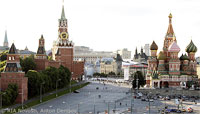Kremlin Policies Increasingly at Odds with Values of Russians, Polls Suggest

(Window on Eurasia – Paul Goble – Staunton, September 26, 2013) The findings of the latest Levada Center survey show, Moscow commentator Sergey Chernyakhovsky says, that most Russians support the values of the left even as Moscow is pursuing policies of the right, a divergence that raises questions about the nature of the country’s political system and its future stability.
Writing on the Novopol portal yesterday, Chernyakhovsky says that the Levada Center survey shows that “present-day Russian society is oriented toward left values, preferences and associations” even though their government is pursuing rightist policies (novopol.ru/-levoe-obschestvo-pravaya-vlast-text151144.html).
This gives rise to questions like the famous one “If you are so smart, why are you so poor?” More specifically, it prompts inquiries like “If society wants a left policy, why are the authorities pursuing a right one?” And finally, “is it possible to consider a society democratic in which the authorities are carrying out a policy not supported by the majority?”
According to the Levada poll, 34 percent of Russians support variants of socialism and 16 percent back communism, while nine percent back liberalism and another nine percent back nationalism. The survey did not ask how many support conservatism, apparently treating support for a firm hand (17 percent) and the agrarian sector (15 percent) as stand ins for that.
That approach may not be appropriate, Chernyakhovsky says, at least for Russia. There, “thanks to the history of the last hundred years and the information war of the last quarter century, these words recall the rule of Stalin as the leader of the communist party, that is, precisely a dictatorship of the left.”
And the word agrarian, for most Russians, is associated “not with feudal rulers but with Soviet collective farms” as was the case with the KPRF’s junior partner in the 1990s, the Agrarian Party.
If one makes those assumptions, he says, then there is the following spectrum of opinion in Russian society, 34 percent are socialists, 16 percent are communists, 17 percent are Stalinists, and 15 percent are collective farmers.” Thus, 82 percent of the Russian people are for policies of the left, and “only 18 percent” divided between nationalists and liberals are for policies of the right.
At the same time, Russia has a sufficiently “right” government, one that is out of step with the Russian population. This is “neither normal nor natural,” all the more so, Chernyakhovsky says because the policies of the right have impoverished and infuriated the population.
Moreover, this split has increased public dissatisfaction and set the stage for conflict. “In such a situation,” the Moscow commentator says, Russia could choose to repeat the path of the 20th century, where a dictatorship of the left would reflect the left views of the population, or it could become a social democracy.
In short, Chernyakhovsky says, the Russia of the 21st century could be a replay of the Soviet system or it could be a social democratic Sweden.
Unfortunately for Russia, the situation is both better and worse than that because “today in Russia power is in the hands of neither the left or the right” in any pure sense. Instead, it is in the hands of the oligarchic clans.” That makes it worse. But it also means that the Kremlinn would choose to move in a left direction.
It will have to do that, Chernyakhovsky says, or “at some point, a government of the left will be established regardless of what the regime wants and will simply replace it.”
